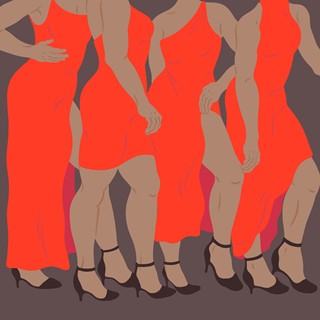"Suffocating or sexy, beguiling or baroque"; Ana Kinsella examines the myriad cultural connotations of that most cardinal of colours
It can almost seem too obvious at first: vivid red, with its powerful cultural connotations of lust, rage, sin and blood. It can be lazy visual shorthand for directors, designers or writers who have swallowed it whole. But then, red does seem to have a life of its own, too: think of Parisian cafés with their crimson awnings and chairs, or of the omnipresent scarlet of London buses and post-boxes. Red is so ubiquitous in daily life that it can be easy to forget everything else we have ascribed to it over the centuries.
Nathaniel Hawthorne’s novel The Scarlet Letter made sure the colour’s power was writ large in Western cultural memory: a bright red A for adulteress on Hester Prynne’s black and white pilgrim costume was enough to mark her out of her New England community, to tar her name as a whore, a shamed woman.
By the 1980s, wearing red had taken on slightly different powers. In his memoir-essay on the decade, critic Wayne Koestenbaum wrote of his own wardrobe. “I wore a bright red Kikit baseball jacket and red espadrilles. I decided that bright blue and red – DayGlo, neon, opalescent – were passports to private revolution.” That idea of private revolution – a secret or a freedom known only to the wearer – calls to mind images of cheap red lace worn underneath office clothes, or the vivid slash of red lipstick on the mouth of a downtrodden housewife. Red, of course, is traditionally the colour of the political left, too. It is personal, and yet it’s public, too. Even when we think we have made our minds up on red and what it means, still it waves on stubbornly like the flag of a forgotten nation.

Fashion
In fashion red is sometimes viewed as a nod to a woman’s sexual power, or a kind of personal brazenness. Guy Bourdin often included glossy red flourishes on lips and fingernails in his strange, seductive fashion photography. Often, especially in the hands of male designers and image-makers, red is seen to represent a woman’s ID: an interior space for hidden desires that manifests only on the edges, in shoes, beauty accents, trashy underwear or accessories.
Yet when worn head-to-toe, red dials up the volume. It leans towards romance, glamour and character: see Julia Roberts in Pretty Woman, heading to the opera in a dazzling red off-the-shoulder dress. That dress echoed Valentino Garavani’s signature gowns in poppy-red rosso Valentino, a perennial favourite for celebrities in need of something classic and still memorable.

Art
That red paints are notorious for fading over time is one of the great ironies of colour in art history. While red can be as striking a choice in oil paints as it is in fashion, the annals of art history are somewhat sparse on the truly vivid red we are looking for. One clear exception is Henri Matisse’s The Dessert: Harmony in Red, in which a woman arranges a table draped with a red patterned cloth, against a wall with the same print. It’s said that this painting started as Harmony in Green, then in blue, then finally Matisse painted over it with red, creating the flattened, strange room that continues to captivate.
Mark Rothko’s Seagram Murals were commissioned by the Four Seasons hotel in 1958, to decorate their new dining room in the building. The painter drove himself half-mad working on the project, completing 30 red-and-purple canvasses though the commission asked for just seven. He wanted them to unsettle the diners at the pricey spot, saying at the time, “I hope to ruin the appetite of every son of a bitch who ever eats in that room.” In the end he withdrew from the commission and instead donated some of the paintings to the Tate.
Finnish artist Sirpa Hakli reinterpreted Johannes Vermeer’s Girl with a Red Hat three centuries after the original was painted, and her version brings to life much of our internal ideas about the colour. In her painting, the girl’s face is blank, and the red colour of the hat dominates the canvas, dripping down like it was blood.

Cinema
In interiors and on screen, red can be suffocating or sexy, beguiling or baroque. In Twin Peaks, David Lynch used the Red Room as an interstitial space from a parallel universe, a place where shadowy truths can emerge and mysteries can begin to unspool. Ingmar Bergman uses red interiors in Cries and Whispers, where a pair of sisters cares for a third sister on her deathbed. The family mansion, with its plush crimson floors and walls, becomes a place where memory, reality, interior life and perspective all are confused. Bergman wrote of the colour in the screenplay: “Ever since my childhood I have pictured the inside of the soul as a moist membrane in shades of red.” The colour, like that in the Rothko murals, seems to channel the suffocating red darkness that we see in the instant when we shut our eyes.
The use of red light and red interiors in Wong Kar-wai’s In the Mood for Love echoes the cramped, halting nature of the connection between Tony Leung and Maggie Cheung on screen, as well as of their fraught inner lives. But perhaps the most iconic and simple use of red, however, might be in Steven Spielberg’s Schindler’s List. The image of the innocent child in a red coat, against the black and white backdrop of the liquidation of the Krákow Ghetto, becomes the striking catalyst for Oskar Schindler to begin his mission to save as many lives as possible, and its power lingers on in the memory long after we first encounter it.
